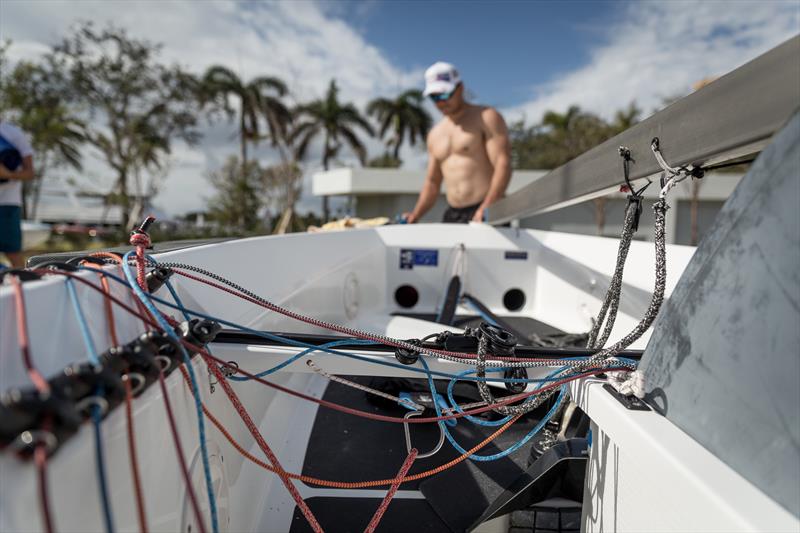
Is your rigging ready?
by Emma Donovan 23 Apr 2019 11:00 BST

Marlow Ropes on a Finn dinghy © Marlow Ropes
At the start of the new sailing season, here are some useful tips & tricks for keeping your ropes ship-shape for safe sailing whilst ensuring you get the most out of them!
If in doubt, always check with your local rigger and chandlery.
The most common causes for ropes to fail are usually as a result of the following, either collectively or in isolation.
- Chafe
- Cutting
- Damage in clutches, wearing in winches
- Chemical damage, UV degradation
- Fatigue
- Tensile overload
Rig Inspections
To ensure you minimise any damage to your rope, it is worth remembering the following:
- Your ropes must be safely stored when not in use, keeping them loosely coiled off the ground (preferably hung) in a locker away from direct sunlight.
- If you think your rope needs to be washed, gently soak them in a bucket of water and avoid using any chemicals. It is often good practice to do this if your ropes have a build up of saltwater as over time this can encourage fatigue.
- Never use anything abrasive to clean your rope as this can damage the fibres.
- Always inspect your hardware to make sure there are no loose bits of metal or sharp sections that can cut or snag your rope fibres.
Terminations
It is worth remembering that a percentage of strength in your rope will be lost when a rope is terminated, either in the form of a knot, lashing or splice.
Knots
Knots are a very common way of terminating a rope, however significant strength is lost when ropes are knotted:
- Nylon/polyester ropes lose 50% strength
- Covered high strength ropes lose 60% strength
- Uncovered high strength ropes lose 70% strength
Actual figures will vary depending on rope type, size, the knot quality.
If you do decide to use a knot, we recommend the following 'Magnificent Seven' which can be used to solve almost any rope problem. If you only learn one knot, a Figure 8 is likely to be the most useful to you.
- Figure 8
- Alpine butterfly
- Reef knot
- Sheet bend
- Clove hitch
- Round turn & 2 half hitches
- Prusik knot
When knotting a rope, strength is lost due to:
- D:d ratio (the diameter ofthe bend compared with the diameter of the rope)
- Compression
- Friction
- Twist
Collectively, this will affect the performance of the rope and specifically in high performance ropes where exotic fibres are often used such as Dyneema or Technora. This is due to the longer braided angles created when the rope is constructed. High performance fibres are low- stretch and therefore unable to accommodate the distortion created when using a knot.
To avoid a lack of strength you must make allowances for strength reduction and as a rule, we recommend splicing over knotting.
Splices
In almost all cases a splice is stronger than a knot, with only 10-15% strength lost.
Splicing is a rewarding skill to learn that will lengthen the life of your rope significantly. We provide various tutorials to demonstrate the following splices, in addition to supplying splicing kits and publishing a step by step Splicing Guide instruction manual which are all available from your local Marlow stockist.
FOR OUR NEW & IMPROVED SPLICING TUTORIALS CLICK HERE.
A good way to start splicing is usually with the D12 Bury Splice (this can develop into the D12 Locking Eye Splice) or the 3 Strand Eye Splice.
Recommended Marlow splices:
- D2 Eyesplice
- Doublebraid
- Marlowbraid
- D12 Locking Eye Splice
- Taper
- 3 Strand Eye Splice
When splicing, it is worth remembering to avoid:
- Short tails which results in the splice slipping and pulling apart.
- Poor tapers a splice typically falls at the taper, learning to taper well is the difference between 10% and 20% reduction in strength.
- Do not rely on 'Brummel' locks in 12 strand ropes this can reduce strength by approximately 30-50%.
For further information about rope care and splicing please click here.
Marlow Ropes is the UK leading manufacturer of high performance ropes, supplied worldwide. Marlow have been making ropes for the Leisure Marine industry in the UK since 1807 and have a wealth of knowledge and expertise in the innovation, construction and development of rope in all its' applications. Marlow Ropes are the official rope supplier to the British Sailing Team, US Sailing Team, the Clipper Round the World Yacht Race and Ineos Team UK.